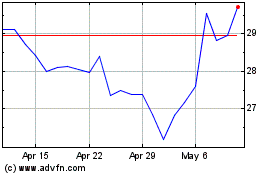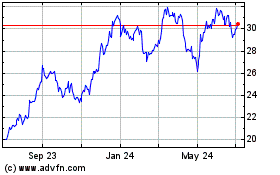By Nick Timiraos
A bipartisan spending deal reached by U.S. lawmakers earlier
this month has prompted many Wall Street economists to raise their
projections of how much the Federal Reserve will raise interest
rates this year and next.
More forecasters say they now expect four Fed rate increases
this year, up from three, because of the deal to increase federal
government spending by $300 billion over the next two years.
The funding bill is more generous than many economists
anticipated, and they predict it could boost U.S. economic growth
in 2018 and '19 by around 0.3 percentage points each year --
roughly the same size increase expected from the $1.5 trillion tax
cut signed into law by President Donald Trump in December.
Economists at UBS Group AG, Nomura Securities and Oxford
Economics in the past week raised their projections for rate
increases, joining other prominent forecasting shops that had
already projected four quarter-percentage-point increases in the
Fed's benchmark short-term interest rate this year.
Nomura sees the Fed raising rates four times this year and twice
next year, adding one more additional rate rise to its forecast in
both years. UBS also added one rate increase to its forecast each
year, now expecting the Fed to raise rates four times this year and
three next year.
Economists at Goldman Sachs Group Inc. and JPMorgan Chase &
Co., which were among those already projecting four rate rises this
year, have said the government spending package makes them more
confident in those calls.
Markets have largely priced in at least three rate increases
this year, and futures trading tracked by CME Group shows investors
have placed a 23% probability on a fourth rate increase.
The Fed's rate-setting decisions matter keenly to markets
because of the likely impact on the values of bonds, stocks,
currencies, real estate and other assets. The policies often,
though not always, influence borrowing costs for households and
businesses, such as through rates on credit cards, mortgages and
corporate loans.
The Fed has raised rates five times since December 2015, most
recently last December to a range between 1.25% and 1.5%.
At their December meeting, officials penciled in three rate
increases for this year and two for 2019. Officials will unveil
their updated projections after their March 20-21 meeting, the
first since Congress completed the spending plan.
The Fed's median projection for short-term rate increases in
2018 appears unlikely to change at that meeting, as it would likely
require at least four out of five officials who have been
projecting three rate increases to raise their estimates.
Economists aren't entirely sure how the tax cut will boost
growth. If household and business spending raises demand but not
the size of the workforce or labor productivity, the Fed might
conclude inflation will rise too far above its 2% target.
If it looks like the tax cut is likely to generate more
investment and hiring -- raising the economy's capacity to produce
goods and services -- the Fed can tolerate faster growth without
accelerating rate increases.
Many economists believe the spending bill will mostly boost
demand for goods and services rather than increase supply, pushing
unemployment down from an already low level. That would likely
prompt Fed officials to raise rates a little more than they
otherwise would, the economists say.
Economists at JPMorgan and UBS now see the unemployment rate
falling to 3.2% at the end of next year, which would be the lowest
level since 1953.
"I see a real challenge for the Fed, not because they're not
capable, but this fiscal stimulus coming now made a hard job even
harder," said Seth Carpenter, chief U.S. economist at UBS and a
former Fed and Treasury official.
Even if the tax cuts end up boosting the economy's output, "this
may take some time before it shows," said Michael Feroli,
JPMorgan's chief U.S. economist, in a research note earlier this
month. "In the meantime, the Fed doesn't have the luxury to wait"
if investors expect inflation to rise.
Some private economists still forecast just three Fed rate
increases this year.
If the Fed moves three times by its September meeting, its
benchmark rate will be positive after adjusting for inflation for
the first time in more than a decade, prompting the central bank to
pause quarterly rate rises and see how the economy is responding,
said Ellen Zentner, chief U.S. economist at Morgan Stanley, in a
client note Tuesday.
Stronger growth over the coming two years could reduce the risk
of a recession in those years, but it could also raise the risk of
one in 2020, when the boost from the spending program fades and
growth slows.
Another risk: The boost in debt-issuance by the U.S. Treasury
resulting from higher budget deficits could lead to higher yields
on government securities, driving up interest rates set by markets,
choking the economy.
"We do not forecast a recession as our base case, but we believe
the risk is material and rising," said Mr. Carpenter.
(END) Dow Jones Newswires
February 20, 2018 14:53 ET (19:53 GMT)
Copyright (c) 2018 Dow Jones & Company, Inc.
UBS (NYSE:UBS)
Historical Stock Chart
From Mar 2024 to Apr 2024

UBS (NYSE:UBS)
Historical Stock Chart
From Apr 2023 to Apr 2024
